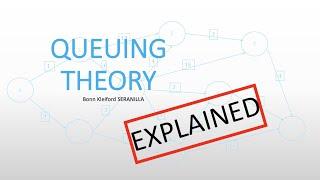
Queuing Theory Tutorial - Queues/Lines, Characteristics, Kendall Notation, M/M/1 Queues
Комментарии:

It helped me a lot. Thank you sir.
Ответить
Thank you for the Video...Explanation was very simple to understand...Appreciate it!
Ответить
BLESSING KA SIR!
Ответить
I am glad I found this theory.
I had investigated this topic on my own and discovered most of this theory on my own without knowing about it.
Now I know of this theory, I can formally study it to improve my productivity further!

amazing bro
thx for simple explanation

Uhm thank you so much I am writing a test tomorrow
Ответить
Great video.🙏🙏🙏🙏
Ответить
Thanks. I never thought about this
Ответить
Thank you for condensing a whole 3 and a half-hour lecture into 15 minutes!
Ответить
thanks for a great work + can you send this powerpoint????
Ответить
thank you so much !
Ответить
God bless you, this is wonderfully explained!
Ответить
Utilization factor would be 1.667 not 0.60 , it's wrong sir
Ответить
Organized and straight to the point. You're amazing.
Ответить
JazakAllah 🔥it helped me alot
Ответить
Anyone who worked the last example what solution did you get
Ответить
thanks for your video, it makes me understand MMS clearer
Ответить
Thank you for the explanation, very useful!
Ответить
Thank you for that lesson ❤ you made it all sound so simple
Ответить
I am 3000 in queue, every minute it is updated, only weekdays. ??????
Ответить
Please help me figure out my wait time
Ответить
Sir can we take this as a final year project for bsc mathematics in college?
Ответить
Thank you for this very useful video!
Ответить
May I ask how to calculate the probability of more than k units last probability? Seems (6/10)**k+1, but k=??
The P0 is easy: 1-(6/10)=0.4

Thankyou so much 🎉 Great explanation
Ответить
Bro God will bless u.
Ответить
God bless you! Great video with great explanation and illustrations, thank you! Hope you could do more video lectures!
Ответить
Superb
Ответить
Made it look so easy
Ответить
beautifully explained
Ответить
Hope some one can help me.
Thanks for your amazing video. One thing is confused here, the definition shows that 'r'dont know how to type= mean number of arrivels per time period and mean number of people or items served per time period. But in your gas station example, why u used mins/car? it should be arrive is 10 cars/hrs, and serve 6 cars/hrs. so, the Ls should be -2.5 cars/hrs. So, my question here is how to explain the negative sign here, or we have to assume service rate have to larger than arrival rate.

Thank you
Ответить
Can I get a solution to this: Demand is: 2,250 vehicles/hr; average speed of 60 mph; capacity of the
lane closure is 25 mph; we have 2 lanes of evenly distributed traffic.
What can we report to be the expected speed of the shock wave traveling
backwards?

why it is not an optimzation technique
Ответить
Thanks for the video, however there is an error in your video. If Lambda (the arrival rate - 10 car per hour) is higher than mu (the service rate - 6 cars per hour) the queue will explode. i.e. the waiting time will be infinite. Could it be that you mixed up the values of lambda and mu?
Ответить
Whoua ndo
Ответить
You presented amazing really it was useful thanks a lot🥰
Ответить
HELLO PO DOC, MAY ANSWER PO BA YANG ASSIGNMENT NA BIGAY NIYO? THANK YOU
Ответить
This information is WOW, thank you.
Ответить
For the example about gas station, I guess the utilization factor is 10/6 = 1.66 and not 6/10 = 0.6
Ответить
can we get the PPT plz sir?
Ответить
im a bit confused on the values for arrival rate and service rate. You used 6 mins and 10 mins, not 1/6 and 1/10 why? from what i understand rate means a quantity per unit of time, but in your calculations you used the time. help me understand plz
Ответить
I am glad I was recommended this.
Ответить
Explaining better than my lecturer
Ответить
excuse me, is there any information about the source of this queuing theory?
Ответить
Should the values of the Erratum also be used for calculating Ws etc in 13.39?
Ответить
Great video
Ответить




![Check out the Conveyor Expansion - Gumball Factory Tycoon [Roblox] Check out the Conveyor Expansion - Gumball Factory Tycoon [Roblox]](https://smotrel.cc/img/upload/WVVzYjllTjBzWm0.jpg)




















